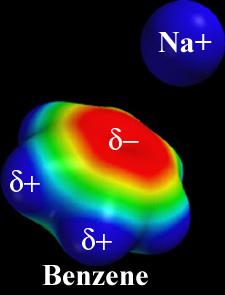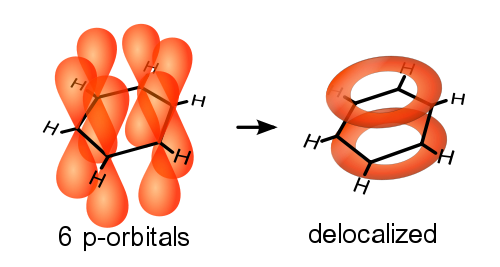Cation-pi interactions
From Proteopedia

|
| Cation-pi interaction. Surfaces colored by electrostatic potential. Image adapted from one kindly provided by Dennis Dougherty. |
Cationic moieties that are within 6.0 Å of the face of an aromatic ring (phenylalanine, tyrosine, or tryptophan) may engage in polar interactions called cation-pi interactions (cation-π interactions)[1].
The flat face of an aromatic ring has a partial negative charge owing to the delocalized pi electrons. Cations such as the sidechains of Lys or Arg, cationic ligands, or metal cations often align themselves centered over the faces of aromatic rings. Over one fourth of Trp's in the Protein Data Bank interact with cations, and 99% of significant cation-pi interactions occur within a distance of 6.0 Angstroms [2]. Cation-pi interactions make a significant contribution to the overall stability of most proteins. Gallivan and Dougherty (1999)[2] concluded that "cation-pi interactions should be considered alongside the more conventional hydrogen bonds, salt bridges, and hydrophobic effects in any analysis of protein structure". They can also contribute significantly to intermolecular contacts and interactions with ligands.
Contents |
Visualization
- FirstGlance in Jmol finds and displays potential cation-pi interactions, as described here.
Chemistry

The cation-pi interaction is a stabilizing electrostatic interaction of a cation with the polarizable pi electron cloud of an aromatic ring. Six-carbon aromatic rings occur in the sidechains of 3 of the 20 standard amino acids: namely phenylalanine, tryptophan, and tyrosine. One p atomic orbital on each aromatic carbon overlaps in a pi ("sideways") fashion with its two neighbors to form a conjugated pi (π) orbital system. The pi electrons of aromatic rings comprise delocalized annular clouds above and below the ring plane (see Figure at right). Proximity of a positive charge to one face of the ring attacts and polarizes the pi electron cloud. In the proper conformation, this proximity forms an energetically significant cation-pi interaction (see Figure above)[3] .
Occurrence and Significance
Gallivan and Dougherty (1999)[2] reported results from a quantitative survey of cation-pi interactions in high-resolution structures in the Protein Data Bank. Using an energy-based criterion for identifying significant sidechain interactions, they studied 593 sequence dissimilar proteins. They found an average of one such interaction per 77 residues, with no significant effect of chain length, or multiple-chain vs. single chain structures. Arg was more likely than Lys to participate in a cation-pi interaction, and the likelihood of aromatic sidechain participation was Trp > Tyr > Phe. Over one quarter of all Trp's were involved in cation-pi interactions, with the cation typically positioned over the 6-atom ring of Trp. Because of the frequencies of amino acids in the database, Arg participates in nearly twice as many cation-pi interactions as does Lys, and the numbers of cation-pi interactions involving Trp, Tyr and Phe are roughly similar. Their study did not include His because, depending on its protonation state, it could participate either as a cation or as a pi-system. Lys and Arg were assumed always to be protonated and hence cationic.
Gallivan and Dougherty conclude "When a cationic sidechain is near an aromatic sidechain, the geometry is biased toward one that would experience a favorable cation-pi interaction", and "cation-pi interactions should be considered alongside the more conventional hydrogen bonds, salt bridges, and hydrophobic effects in any analysis of protein structure". They provide a server that lists text results from their program CaPTURE.
Zacharias and Dougherty (2002)[4] reviewed cation-pi interactions in the binding of ligands to proteins. Cation-pi interactions are usually energetically important when the ligand has either positive charge or an aromatic ring, and are involved in control of ion channels, G-protein-coupled receptors, transporters, and enzymatic catalysis.
Examples
| |||||||||||
Literature References & Notes
- ↑ Dougherty DA. The cation-π interaction. Acc Chem Res. 2013 Apr 16;46(4):885-93. PMID:23214924 doi:10.1021/ar300265y
- ↑ 2.0 2.1 2.2 2.3 Gallivan JP, Dougherty DA. Cation-pi interactions in structural biology. Proc Natl Acad Sci U S A. 1999 Aug 17;96(17):9459-64. PMID:10449714
- ↑ Eric Martz thanks Peter Lillya for help writing this paragraph.
- ↑ 4.0 4.1 Zacharias N, Dougherty DA. Cation-pi interactions in ligand recognition and catalysis. Trends Pharmacol Sci. 2002 Jun;23(6):281-7. PMID:12084634
- ↑ 5.0 5.1 5.2 5.3 5.4 5.5 5.6 Xiu X, Puskar NL, Shanata JA, Lester HA, Dougherty DA. Nicotine binding to brain receptors requires a strong cation-pi interaction. Nature. 2009 Mar 26;458(7237):534-7. Epub 2009 Mar 1. PMID:19252481 doi:10.1038/nature07768
- ↑ In contrast, the 6-membered pyridine ring has a pKa of 3.1, so is uncharged at neutral pH. The uncharged or free base form of nicotine is more volatile than the charged form. Cigarette manufacturers have long added ammonia to tobacco to increase absorption of nicotine by smokers. See Summerfield, 1999 cited elsewhere for details.
- ↑ Summerfield, J. H. An acid-base chemistry example: conversion of nicotine. J. Chem. Ed. 76:1397-8 (1999).
- ↑ 8.0 8.1 Zhong W, Gallivan JP, Zhang Y, Li L, Lester HA, Dougherty DA. From ab initio quantum mechanics to molecular neurobiology: a cation-pi binding site in the nicotinic receptor. Proc Natl Acad Sci U S A. 1998 Oct 13;95(21):12088-93. PMID:9770444
- ↑ 9.0 9.1 Beene DL, Brandt GS, Zhong W, Zacharias NM, Lester HA, Dougherty DA. Cation-pi interactions in ligand recognition by serotonergic (5-HT3A) and nicotinic acetylcholine receptors: the anomalous binding properties of nicotine. Biochemistry. 2002 Aug 13;41(32):10262-9. PMID:12162741
- ↑ These examples were noted in the documentation for Protein Explorer: see Content Attribution for the original documentation.
Additional Literature
- Dougherty DA. Cation-pi interactions in chemistry and biology: a new view of benzene, Phe, Tyr, and Trp. Science. 1996 Jan 12;271(5246):163-8. PMID:8539615
- Beene DL, Brandt GS, Zhong W, Zacharias NM, Lester HA, Dougherty DA. Cation-pi interactions in ligand recognition by serotonergic (5-HT3A) and nicotinic acetylcholine receptors: the anomalous binding properties of nicotine. Biochemistry. 2002 Aug 13;41(32):10262-9. PMID:12162741
- Gromiha MM, Santhosh C, Ahmad S. Structural analysis of cation-pi interactions in DNA binding proteins. Int J Biol Macromol. 2004 Jun;34(3):203-11. PMID:15225993 doi:http://dx.doi.org/10.1016/j.ijbiomac.2004.04.003
- Crowley PB, Golovin A. Cation-pi interactions in protein-protein interfaces. Proteins. 2005 May 1;59(2):231-9. PMID:15726638 doi:http://dx.doi.org/10.1002/prot.20417
- Gromiha MM, Suwa M. Structural analysis of residues involving cation-pi interactions in different folding types of membrane proteins. Int J Biol Macromol. 2005 Mar;35(1-2):55-62. Epub 2005 Jan 28. PMID:15769516 doi:http://dx.doi.org/10.1016/j.ijbiomac.2004.12.001
- Prajapati RS, Sirajuddin M, Durani V, Sreeramulu S, Varadarajan R. Contribution of cation-pi interactions to protein stability. Biochemistry. 2006 Dec 19;45(50):15000-10. PMID:17154537 doi:http://dx.doi.org/10.1021/bi061275f
- Crowley PB, Golovin A. Cation-pi interactions in protein-protein interfaces. Proteins. 2005 May 1;59(2):231-9. PMID:15726638 doi:http://dx.doi.org/10.1002/prot.20417
- Dougherty DA. Cation-pi interactions involving aromatic amino acids. J Nutr. 2007 Jun;137(6 Suppl 1):1504S-1508S; discussion 1516S-1517S. PMID:17513416
- Wu R, McMahon TB. Investigation of cation-pi interactions in biological systems. J Am Chem Soc. 2008 Sep 24;130(38):12554-5. Epub 2008 Aug 29. PMID:18759391 doi:http://dx.doi.org/10.1021/ja802117s
- Sussman JL, Harel M, Frolow F, Oefner C, Goldman A, Toker L, Silman I. Atomic structure of acetylcholinesterase from Torpedo californica: a prototypic acetylcholine-binding protein. Science. 1991 Aug 23;253(5022):872-9. PMID:1678899
- Harel M, Aharoni A, Gaidukov L, Brumshtein B, Khersonsky O, Meged R, Dvir H, Ravelli RB, McCarthy A, Toker L, Silman I, Sussman JL, Tawfik DS. Structure and evolution of the serum paraoxonase family of detoxifying and anti-atherosclerotic enzymes. Nat Struct Mol Biol. 2004 May;11(5):412-9. Epub 2004 Apr 18. PMID:15098021 doi:10.1038/nsmb767
- Felder C, Jiang HL, Zhu WL, Chen, KX, Silman I, Botti, SA, Sussman JL. Quantum/classical mechanical comparison of cation-π interactions between tetramethylammonium and benzene. J. Phys. Chem. 2001 A 105: 1326-1333. Paper.
- Tan XJ, Zhu WL, Cui M, Luo XM, Gu JD, Silman I, Sussman JL, Jiang HL, Ji RY, Chen KX. Noncovalent interaction or chemical bonding between alkaline earth cations and benzene? A quantum chemistry study with MP2 and density-functional theory methods. Chem. Phys. Lett. 2001 349:113-122. Abstract
- Sussman JL, Silman I. Acetylcholinesterase: structure and use as a model for specific cation-protein interactions. Curr. Opin. Struct. Biol. 1992 2:721-729. Abstract
See Also
- Search PubMed for Dougherty DA.
- Acetyl Choline Receptor - Molecule of the Month.
- The Introduction, Gallery & Tutorial for Cation-Pi Interactions from Eric Martz's Protein Explorer
- Wikipedia Cation-pi interaction page
Content Attribution
The initial content of this page was adapted, with the permission of Eric Martz, from the Glossary and Introduction, Gallery & Tutorial for Cation-Pi Interactions that accompanies Protein Explorer. Eric Martz is grateful to Peter Lillya for help with chemical terminology and concepts.
Proteopedia Page Contributors and Editors (what is this?)
Eric Martz, Wayne Decatur, Alexander Berchansky, Michal Harel
DOI: https://dx.doi.org/10.14576/351028.1258908 (?)Citation: Decatur W, Martz E, Harel M, 2011, "Cation-pi interactions",
